
MBus
Encyclopedia


Computer bus
In computer architecture, a bus is a subsystem that transfers data between components inside a computer, or between computers.Early computer buses were literally parallel electrical wires with multiple connections, but the term is now used for any physical arrangement that provides the same...
designed and implemented by Sun Microsystems
Sun Microsystems
Sun Microsystems, Inc. was a company that sold :computers, computer components, :computer software, and :information technology services. Sun was founded on February 24, 1982...
for communication between high speed computer system components, such as the central processing unit
Central processing unit
The central processing unit is the portion of a computer system that carries out the instructions of a computer program, to perform the basic arithmetical, logical, and input/output operations of the system. The CPU plays a role somewhat analogous to the brain in the computer. The term has been in...
, motherboard
Motherboard
In personal computers, a motherboard is the central printed circuit board in many modern computers and holds many of the crucial components of the system, providing connectors for other peripherals. The motherboard is sometimes alternatively known as the mainboard, system board, or, on Apple...
and main memory. Contrast this with SBus
SBus
SBus is a computer bus system that was used in most SPARC-based computers from Sun Microsystems and others during the 1990s...
, used in the same machines to connect add-on cards to the motherboard.
MBus was first used in Sun's first multiprocessor
Multiprocessor
Computer system having two or more processing units each sharing main memory and peripherals, in order to simultaneously process programs.Sometimes the term Multiprocessor is confused with the term Multiprocessing....
SPARC
SPARC
SPARC is a RISC instruction set architecture developed by Sun Microsystems and introduced in mid-1987....
-based system, the SPARCserver 600MP series (launched in 1991), and later found use in the SPARCstation 10
SPARCstation 10
The SPARCstation 10 is a workstation computer made by Sun Microsystems. Announced in May 1992, it was Sun's first desktop multiprocessor...
and SPARCstation 20
SPARCstation 20
The SPARCstation 20 is a Sun Microsystems workstation based on the SuperSPARC or hyperSPARC CPU. It was the last model in the SPARCstation family of Sun "pizza box" computers, which was superseded by the UltraSPARC design in 1995.-CPU support:The SPARCstation 20 had dual 50 MHz MBus ports that...
workstations. The bus permitted the integration of several microprocessors on a single motherboard, in a multiprocessing
Multiprocessing
Multiprocessing is the use of two or more central processing units within a single computer system. The term also refers to the ability of a system to support more than one processor and/or the ability to allocate tasks between them...
configuration with up to eight CPUs packaged in detachable MBus modules. However, in practice, the number of processors per MBus was limited to four. Single processor systems were also sold that used the MBus protocol internally, but with the CPUs permanently attached to the motherboard to lower manufacturing costs.
MBus specified a 64-bit
Bit
A bit is the basic unit of information in computing and telecommunications; it is the amount of information stored by a digital device or other physical system that exists in one of two possible distinct states...
datapath, which used 36-bit physical addressing, giving an address space of 64 GB
Gigabyte
The gigabyte is a multiple of the unit byte for digital information storage. The prefix giga means 109 in the International System of Units , therefore 1 gigabyte is...
. The transfer rate is 80 MB
Megabyte
The megabyte is a multiple of the unit byte for digital information storage or transmission with two different values depending on context: bytes generally for computer memory; and one million bytes generally for computer storage. The IEEE Standards Board has decided that "Mega will mean 1 000...
/s sustained (320 MB/s peak) at 40 MHz, or 100 MB/s (400 MB/s peak) at 50 MHz. Bus controlling is done by an arbiter
Arbiter (electronics)
-Asynchronous arbiters:An important form of arbiter is used in asynchronous circuits, to select the order of access to a shared resource among asynchronous requests. Its function is to prevent two operations from occurring at once when they should not...
. Interrupt, reset, and timeout logic are also specified.
Several related buses were also developed:
XBus: a packet-switched bus used in the SPARCserver 1000, SPARCcenter 2000 and Cray CS6400
Cray CS6400
The Cray Superserver 6400, or CS6400, was a multiprocessor server computer system produced by Cray Research Superservers, Inc., a subsidiary of Cray Research, and launched in 1993...
. This corresponded to the circuit-switched MBus, with identical electrical characteristics and physical form factor but an incompatible signalling protocol.
KBus: a high-speed interconnection system for linking multiple MBuses, used in Solbourne Series 6 and Series 7 computer systems.
Manufacturers who produced computer systems using the MBus included Sun, Ross Technology, Inc.
Ross Technology, Inc.
Ross Technology, Inc. was a semiconductor design and manufacturing company, specializing in SPARC microprocessors. It was founded in Austin, Texas in August 1988 by Dr. Roger D. Ross, a leading computer scientist who headed Motorola's Advanced Microprocessor Division and directed the developments...
, Hyundai
Hyundai
Hyundai ) is a global conglomerate company, part of the Korean chaebol, that was founded in South Korea by one of the most famous businessmen in Korean history: Chung Ju-yung...
/Axil, Fujitsu
Fujitsu
is a Japanese multinational information technology equipment and services company headquartered in Tokyo, Japan. It is the world's third-largest IT services provider measured by revenues....
, Solbourne Computer
Solbourne Computer
Solbourne Computer Inc. was originally a vendor of computer systems based in Longmont, Colorado, USA, at first 52% owned by Matsushita. In the late 1980s and early '90s, the company produced a range of computer workstations and servers based on the SPARC microprocessor architecture, largely...
, Tatung
Tatung Company
Tatung Company , also known as Tatung, is a multinational corporation established in 1918 and headquartered in Zhongshan, Taipei, Taiwan. Tatung also maintains a regional headquarters in Long Beach, California for the U.S...
, GCS, Auspex
Auspex
Auspex, Inc. was founded 1985 by Michael Henney, Burt Brockman and Terry Kisner to develop SCADA software systems. In 1986, Rich Newell joined Auspex and the company started providing software support for SGM, Inc.'s RCS-7 line of SCADA products. In 1987 Auspex acquired the RCS-7 product line from...
, ITRI
Itri
Itri is a small city and comune in the central Italian region of Latium and the Province of Latina.Itri is an agricultural centre divided in two parts by a small river, the Pontone. It lies in a valley between the Monti Aurunci and the sea, not far from the Gulf of Gaeta...
, ICL, Cray
Cray
Cray Inc. is an American supercomputer manufacturer based in Seattle, Washington. The company's predecessor, Cray Research, Inc. , was founded in 1972 by computer designer Seymour Cray. Seymour Cray went on to form the spin-off Cray Computer Corporation , in 1989, which went bankrupt in 1995,...
, Amdahl
Amdahl Corporation
Amdahl Corporation is an information technology company which specializes in IBM mainframe-compatible computer products. Founded in 1970 by Dr. Gene Amdahl, a former IBM employee, it has been a wholly owned subsidiary of Fujitsu since 1997...
, Themis
Themis
Themis is an ancient Greek Titaness. She is described as "of good counsel", and is the embodiment of divine order, law, and custom. Themis means "divine law" rather than human ordinance, literally "that which is put in place", from the verb τίθημι, títhēmi, "to put"...
and DTK.

